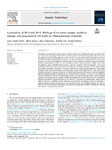Mostrar o rexistro simple do ítem
Cytotoxicity of BP-3 and BP-4: Blockage of Extrusion Pumps, Oxidative Damage and Programmed Cell Death on Chlamydomonas reinhardtii
| dc.contributor.author | Anido Varela, Laura | |
| dc.contributor.author | Seoane, Marta | |
| dc.contributor.author | Esperanza, Marta | |
| dc.contributor.author | Cid, Ángeles | |
| dc.contributor.author | Rioboo, Carmen | |
| dc.date.accessioned | 2023-06-22T14:58:04Z | |
| dc.date.available | 2023-06-22T14:58:04Z | |
| dc.date.issued | 2022-09-07 | |
| dc.identifier.citation | Laura Anido-Varela, Marta Seoane, Marta Esperanza, Ángeles Cid, Carmen Rioboo, Cytotoxicity of BP-3 and BP-4: Blockage of extrusion pumps, oxidative damage and programmed cell death on Chlamydomonas reinhardtii, Aquatic Toxicology, Volume 251, 2022, 106285, ISSN 0166-445X, https://doi.org/10.1016/j.aquatox.2022.106285. (https://www.sciencedirect.com/science/article/pii/S0166445X22002119) | es_ES |
| dc.identifier.issn | 0166-445X | |
| dc.identifier.uri | http://hdl.handle.net/2183/33240 | |
| dc.description | Financiado para publicación en acceso aberto: Universidade da Coruña/CISUG | es_ES |
| dc.description.abstract | [Abstract] The health concern associated with the dangers related to exposure to UV radiation has led to an increase in the use of sunscreens containing UV-filters that can reach aquatic environments and possibly affect ecosystems. Benzophenone-3 (BP-3) and benzophenone-4 (BP-4) are two of the most used UV-filters. In the present work, the microalga Chlamydomonas reinhardtii was exposed to several concentrations of both chemicals. To evaluate their potential cytotoxicity on microalgal cells, different parameters were analysed including fast response biomarkers (increase in intracellular free Ca2+) as well as biomarkers related with the presence of oxidative stress (lipid peroxidation), energy metabolism (photosynthetic yield and cytoplasmic lipid accumulations), cell division (proliferation and F-actin content), programmed cell death (PCD) (caspase activation and DNA fragmentation) and possible mechanisms of resistance to xenobiotics (operation of extrusion pumps and presence of autophagic vacuoles). Results showed an increment of the percentage of cells with cytosolic free Ca2+ that could act as a secondary messenger in response to the stress. A decrease in photosynthetic yield and an increase in cytoplasmic lipid accumulations and lipid peroxidation levels were also detected. In addition, a decrease in cell proliferation was observed, linked to a decrease in the percentage of cells with F-actin. The increase observed in the microalgal population with caspase activity, together with the DNA fragmentation and the alterations in the cytoskeleton, suggested the induction of processes linked to PCD. Moreover, a blockage of extrusion pumps, which could be related to the toxicity mechanism of these compounds, and an increase in autophagic vacuoles, as an attempt to repair the damage caused by benzophenones, were detected. Overall, these biomarkers indicate that both UV-filters can be a serious threat to non-target photosynthetic microorganisms in aquatic environments, although BP-3 affected C. reinhardtii more markedly. | es_ES |
| dc.description.sponsorship | This research has been funded by Spanish “Ministerio de Economía, Industria y Competitividad” (CTM2017- 88668-R). M. S. and M. E. were funded by a grant from “Diputación Provincial de A Coruña” | es_ES |
| dc.language.iso | eng | es_ES |
| dc.publisher | Elsevier | es_ES |
| dc.relation | info:eu-repo/grantAgreement/AEI/Plan Estatal de Investigación Científica y Técnica y de Innovación 2017-2020/CTM2017-88668-R/ES/PARAMETROS DE RESPUESTA CITOTOXICA DE MICROALGAS PARA LA PROSPECCION DE EFECTOS TOXICOS DE CONTAMINANTES EMERGENTES EN SISTEMAS ACUATICOS MARINOS Y DULCEACUICOLAS/ | es_ES |
| dc.relation.uri | https://doi.org/10.1016/j.aquatox.2022.106285 | es_ES |
| dc.rights | Atribución 4.0 Internacional | es_ES |
| dc.rights.uri | http://creativecommons.org/licenses/by/4.0/ | * |
| dc.subject | Microalga | es_ES |
| dc.subject | UV-filters | es_ES |
| dc.subject | Flow cytometry | es_ES |
| dc.subject | Comet assay | es_ES |
| dc.subject | Cytoplasmic Ca2+ | es_ES |
| dc.subject | Autophagic vacuoles | es_ES |
| dc.title | Cytotoxicity of BP-3 and BP-4: Blockage of Extrusion Pumps, Oxidative Damage and Programmed Cell Death on Chlamydomonas reinhardtii | es_ES |
| dc.type | info:eu-repo/semantics/article | es_ES |
| dc.rights.access | info:eu-repo/semantics/openAccess | es_ES |
| UDC.journalTitle | Aquatic Toxicology | es_ES |
| UDC.volume | 251 (October 2022) | es_ES |
| UDC.issue | es_ES | |
| UDC.startPage | 106285 | es_ES |
| dc.identifier.doi | 10.1016/j.aquatox.2022.106285 |






